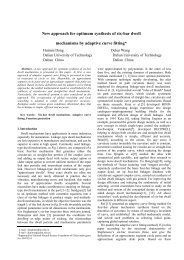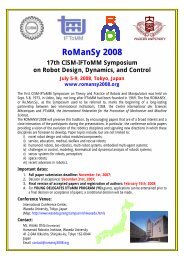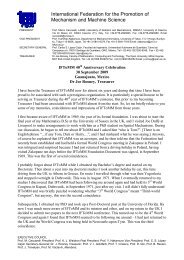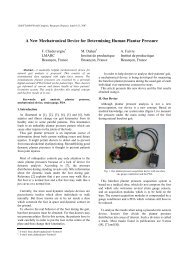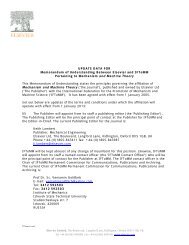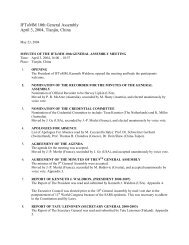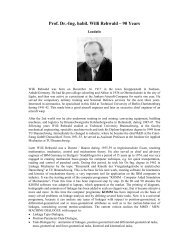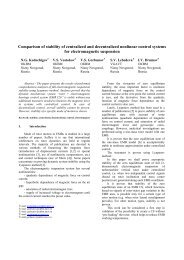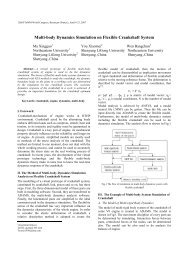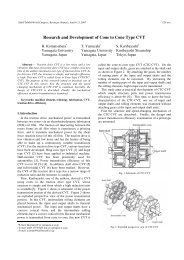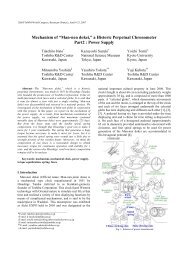A simple technique for measuring the base helix angle of ... - IFToMM
A simple technique for measuring the base helix angle of ... - IFToMM
A simple technique for measuring the base helix angle of ... - IFToMM
You also want an ePaper? Increase the reach of your titles
YUMPU automatically turns print PDFs into web optimized ePapers that Google loves.
12th <strong>IFToMM</strong> World Congress, Besançon, June 18-21, 2007 406<br />
As is known, <strong>the</strong> span measurement is feasible only if <strong>the</strong><br />
width L <strong>of</strong> <strong>the</strong> gear satisfies <strong>the</strong> following inequality<br />
L > W sin β<br />
(5)<br />
k<br />
b<br />
s b<br />
capable <strong>of</strong> generating an involute gear characterized by a<br />
given set <strong>of</strong> values <strong>for</strong> z, ρ, β b , and s b .<br />
Additional geometric parameters such as tip diameter,<br />
root diameter, etc., will be disregarded in this paper.<br />
A. The span measurement<br />
The span (or Wildhaber) measurement W k <strong>of</strong> an external<br />
helical involute gear as a function <strong>of</strong> <strong>the</strong> basic geometric<br />
parameters <strong>of</strong> <strong>the</strong> gear is provided by ([1]-[8])<br />
( 1)<br />
W = k − p + s<br />
(1)<br />
k bn bn<br />
where k is <strong>the</strong> number <strong>of</strong> gear teeth interposed between<br />
<strong>the</strong> disc anvils <strong>of</strong> <strong>the</strong> micrometer; p bn is <strong>the</strong> normal <strong>base</strong><br />
pitch <strong>of</strong> <strong>the</strong> gear ([8]), i.e., <strong>the</strong> distance – measured on <strong>the</strong><br />
<strong>base</strong> cylinder – between <strong>the</strong> <strong>base</strong> helices <strong>of</strong> homologous<br />
involute helicoids <strong>of</strong> two adjacent teeth (it is also <strong>the</strong><br />
linear distance between <strong>the</strong> a<strong>for</strong>ementioned involute<br />
helicoids); and s bn is <strong>the</strong> <strong>base</strong> normal thickness <strong>of</strong> a tooth,<br />
i.e., <strong>the</strong> distance – measured on <strong>the</strong> <strong>base</strong> cylinder –<br />
between <strong>the</strong> two <strong>base</strong> helices <strong>of</strong> <strong>the</strong> same tooth. Quantity<br />
p bn is related to <strong>the</strong> transverse <strong>base</strong> pitch p b by <strong>the</strong><br />
following condition ([8])<br />
p = p cos β<br />
(2)<br />
bn b b<br />
where p b is obviously given by<br />
p b<br />
2 π ρ<br />
= (3)<br />
z<br />
Similarly, <strong>the</strong> relationship between <strong>the</strong> <strong>base</strong> normal<br />
thickness s bn and <strong>the</strong> transverse normal thickness s b is<br />
s<br />
ρ<br />
β b<br />
Fig. 1. Key parameters <strong>of</strong> an involute helical gear.<br />
= s cos β (4)<br />
bn b b<br />
B. The overpin measurement<br />
For <strong>the</strong> measurement over pins (or balls), <strong>the</strong> distance e<br />
<strong>of</strong> <strong>the</strong> pin axes (ball centers) from <strong>the</strong> gear axis is related<br />
to <strong>the</strong> measured value F a by <strong>the</strong> ensuing condition ([1]-<br />
[4], [8], [9])<br />
Fa<br />
m a<br />
e =<br />
⎡π<br />
⎛ z ⎞⎤<br />
2sin ⎢ int ⎜ ⎟<br />
z 2 ⎥<br />
⎣ ⎝ ⎠⎦<br />
where a is <strong>the</strong> diameter <strong>of</strong> both pins (balls) and int(.) is <strong>the</strong><br />
function that returns <strong>the</strong> integer part <strong>of</strong> its argument. In<br />
Eq. (6) and in <strong>the</strong> sequel <strong>of</strong> this subsection, <strong>the</strong> upper or<br />
lower sign has to be used depending on whe<strong>the</strong>r <strong>the</strong> gear<br />
is external or, respectively, internal.<br />
In turn, quantity e depends both on <strong>the</strong> basic geometric<br />
parameters <strong>of</strong> <strong>the</strong> inspected gear and on <strong>the</strong> pin diameter<br />
according to <strong>the</strong> following expression<br />
(6)<br />
ρ<br />
e = (7)<br />
cosϑ<br />
In Eq. (7) <strong>angle</strong> ϑ is implicitly provided by<br />
⎛ sbn<br />
+ a π ⎞<br />
invϑ<br />
= ± ⎜ − ⎟<br />
⎝ 2ρ<br />
cos βb<br />
z ⎠<br />
Function inv(.) appearing in Eq. (8) is defined by<br />
(8)<br />
inv u = tan u − u<br />
(9)<br />
In evaluating <strong>the</strong> right-hand side <strong>of</strong> Eq. (9), <strong>angle</strong> u has to<br />
be expressed in radians.<br />
III. The three <strong>measuring</strong> <strong>technique</strong>s<br />
This section will briefly review <strong>the</strong> existing <strong>measuring</strong><br />
<strong>technique</strong> [7] and presents <strong>the</strong> new ones. All three<br />
<strong>technique</strong>s will be explained by referring to external<br />
gears, though <strong>the</strong> last one is suitable <strong>for</strong> internal gears too.<br />
A. Two span measurement and one overpin measurements<br />
Once it has been recognized that <strong>the</strong> fundamental<br />
geometric parameters <strong>of</strong> an involute gear are four (z, ρ, β b ,<br />
and s b , or equivalently – thanks to Eq. (4) – z, ρ, β b , and<br />
s bn ) it is a matter <strong>of</strong> course that three distinct<br />
measurements are necessary – in addition to <strong>the</strong> count <strong>of</strong><br />
<strong>the</strong> number z <strong>of</strong> teeth – in order to identify a gear.<br />
According to <strong>the</strong> procedure presented in [7], two span<br />
measurements have to be taken with different values <strong>of</strong> k,<br />
<strong>for</strong> instance, k and k + 1 . These two measurements allow<br />
linear determination <strong>of</strong> quantities p bn and s bn ([4], see also<br />
Eqs. (1))<br />
2



